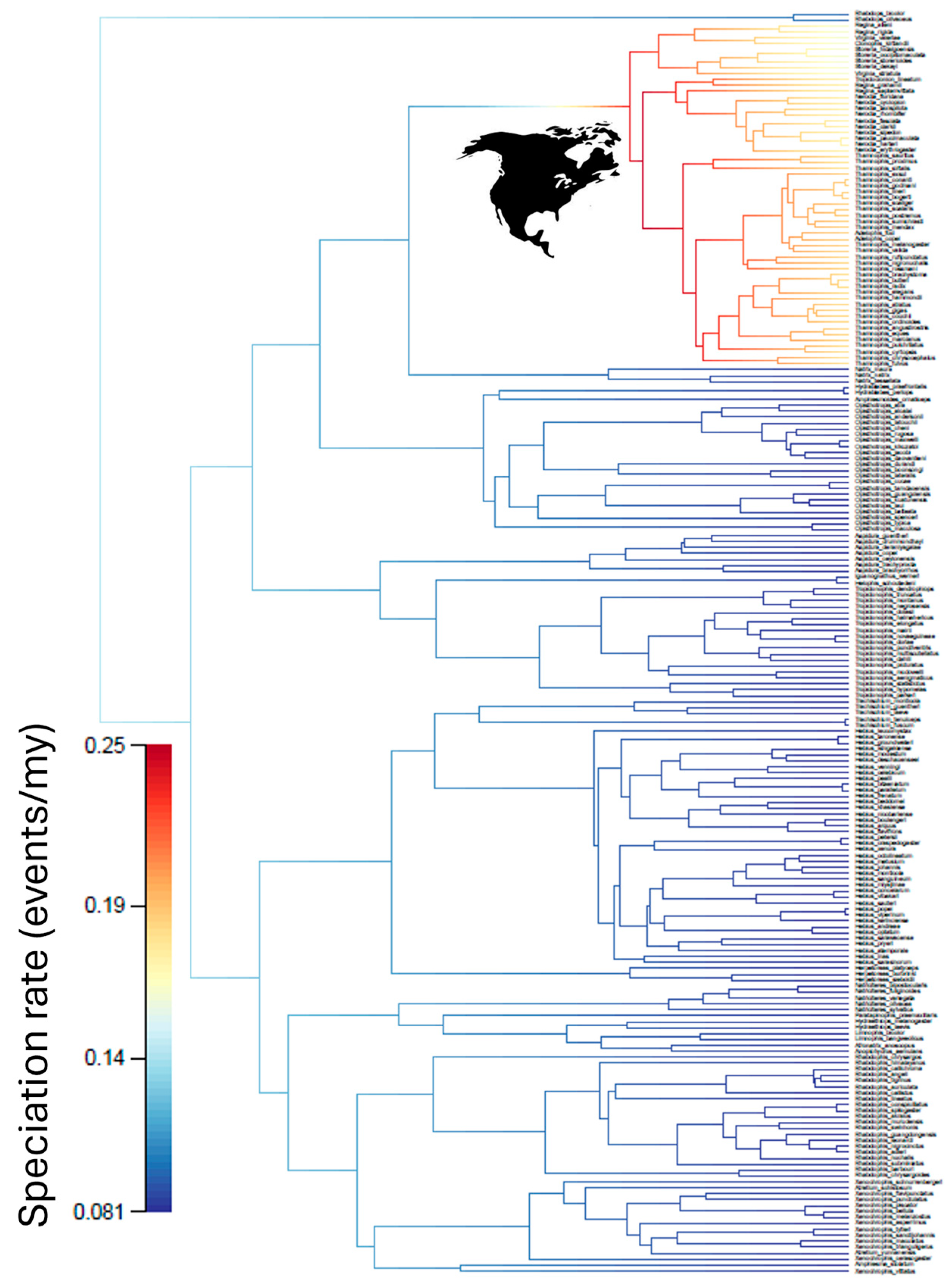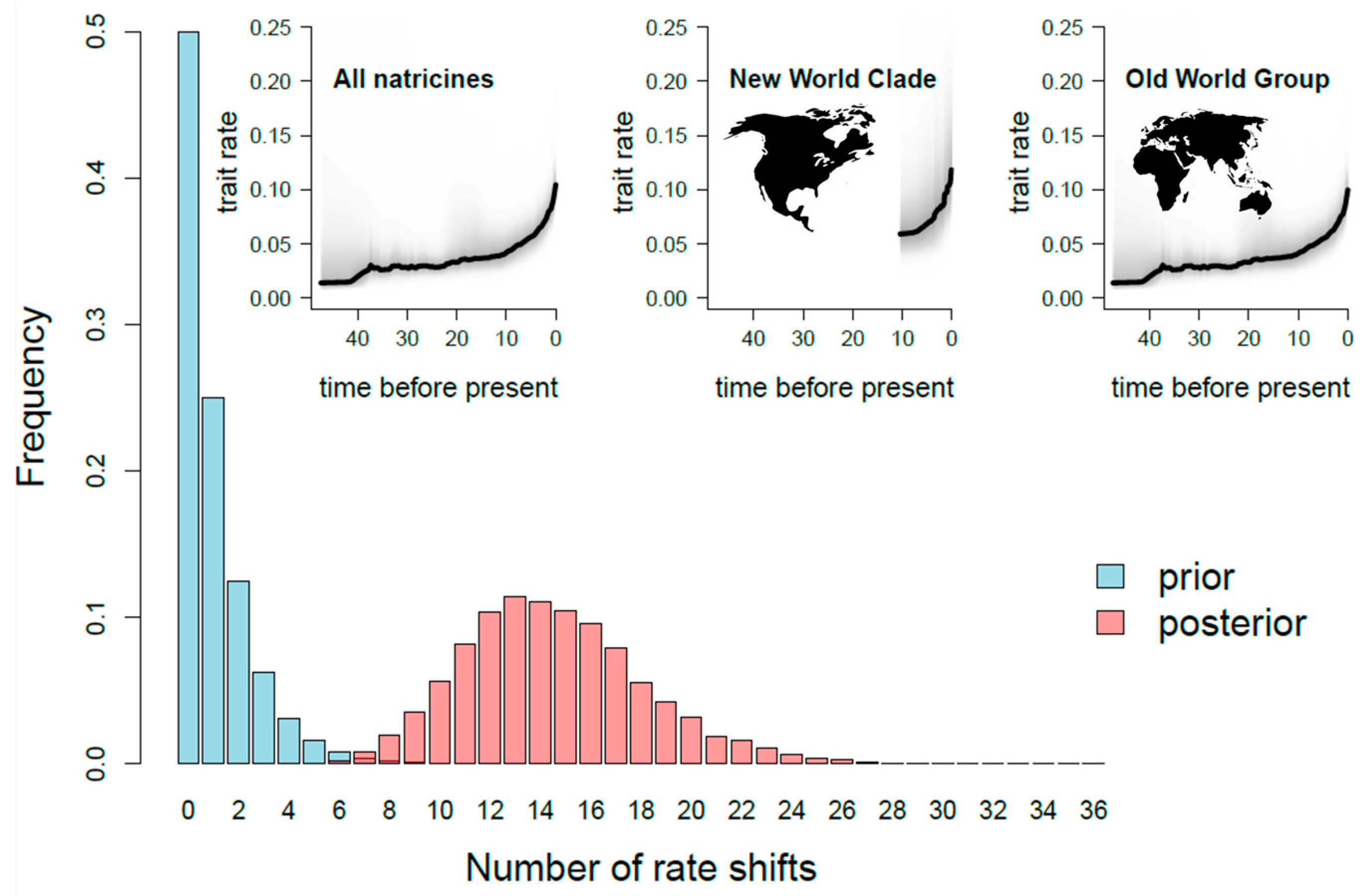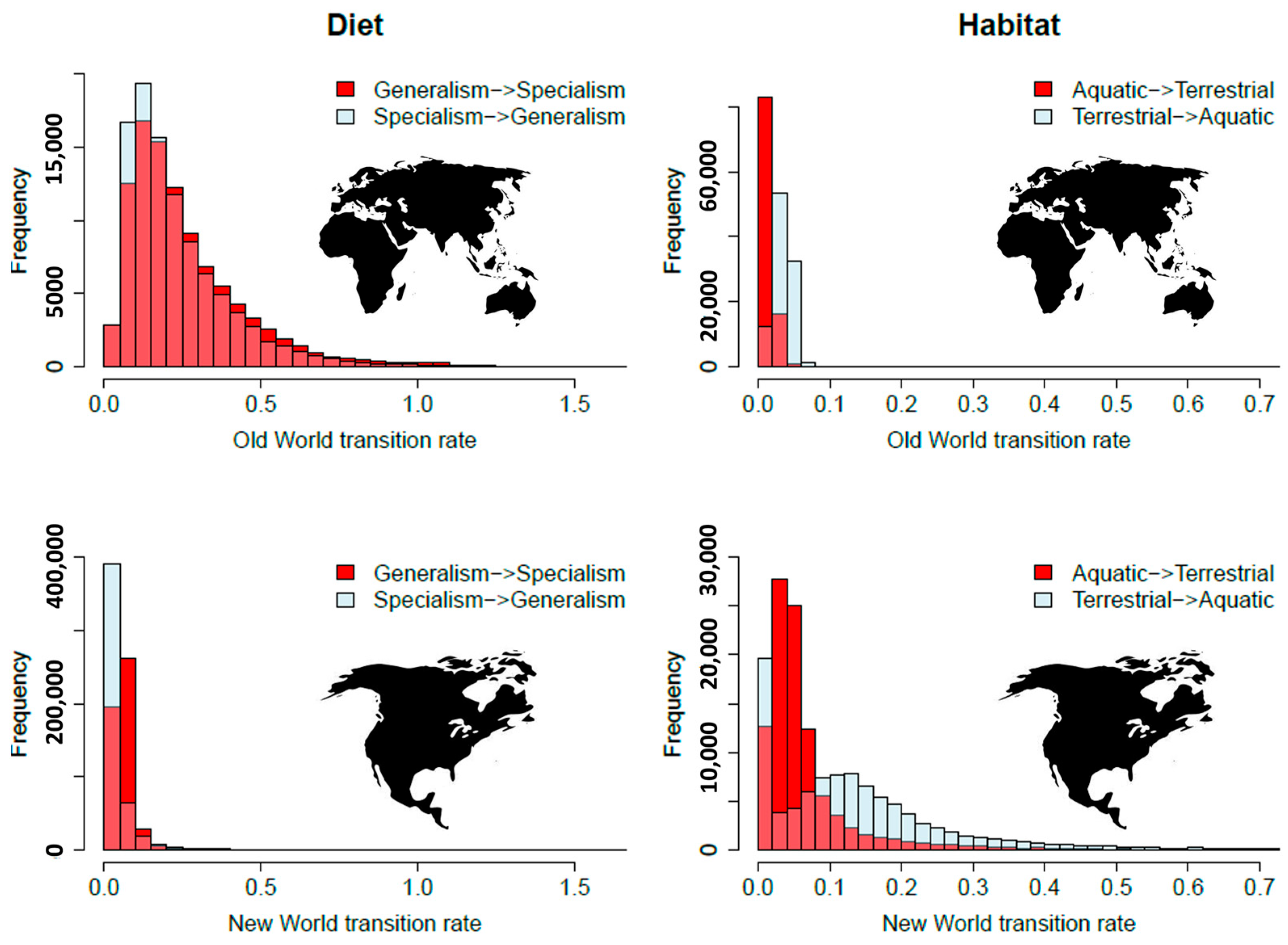Flowing Round the World: Water Snakes (Natricidae) Show Habitat-Related Adaptive Radiation After Dispersal to the New World
Abstract
1. Introduction
2. Materials and Methods
2.1. Phylogenetic Tree
2.2. Historical Biogeography
2.3. Diversification Dynamics
2.4. Trait Evolutionary Rates
3. Results
4. Discussion
Author Contributions
Funding
Institutional Review Board Statement
Data Availability Statement
Acknowledgments
Conflicts of Interest
References
- Schluter, D. The Ecology of Adaptive Radiation; Oxford University Press: Oxford, UK, 2000. [Google Scholar]
- Hernández-Hernández, T. Evolutionary rates and adaptive radiations. Biol. Philos. 2019, 34, 41. [Google Scholar] [CrossRef]
- Morinaga, G.; Wiens, J.J.; Moen, D.S. The radiation continuum and the evolution of frog diversity. Nat. Comm. 2023, 14, 7100. [Google Scholar] [CrossRef]
- Grant, B.R. Evolution in Darwin’s Finches: A review of a study on Isla Daphne Major in the Galápagos Archipelago. Zoology 2003, 106, 255–259. [Google Scholar]
- Ronco, F.; Matschiner, M.; Böhne, A.; Boila, A.; Büscher, H.H.; El Taher, A.; Indermaur, A.; Malinsky, M.; Ricci, V.; Kahmen, A.; et al. Drivers and dynamics of a massive adaptive radiation in cichlid fishes. Nature 2021, 589, 76–81. [Google Scholar] [CrossRef] [PubMed]
- Peoples, N.; Burns, M.D.; Mihalitsis, M.; Wainwright, P.C. Evolutionary lability of a key innovation spurs rapid diversification. Nature 2025, 639, 962–967. [Google Scholar] [CrossRef] [PubMed]
- Herrera, J.P. Testing the adaptive radiation hypothesis for the lemurs of Madagascar. R. Soc. Open Sci. 2017, 4, 161014. [Google Scholar] [CrossRef]
- Vizueta, J.; Macías-Hernández, N.; Arnedo, M.A.; Rozas, J.; Sánchez-Gracia, A. Chance and predictability in evolution: The genomic basis of convergent dietary specializations in an adaptive radiation. Mol. Ecol. 2019, 28, 4028–4045. [Google Scholar] [CrossRef]
- Patton, A.H.; Harmon, L.J.; del Rosario Castañeda, M.; Frank, H.K.; Donihue, C.M.; Herrel, A.; Losos, J.B. When adaptive radiations collide: Different evolutionary trajectories between and within island and mainland lizard clades. Proc. Natl. Acad. Sci. USA 2021, 118, e2024451118. [Google Scholar] [CrossRef]
- Dugo-Cota, A.; Vila, C.; Rodrıguez, A.; Gonzalez-Voyer, A. Ecomorphological convergence in Eleutherodactylus frogs: A case of replicate radiations in the Caribbean. Ecol. Lett. 2019, 22, 884–893. [Google Scholar] [CrossRef]
- Esquerré, D.; Brennan, I.G.; Donnellan, S.; Keogh, J.S. Evolutionary models demonstrate rapid and adaptive diversification of Australo-Papuan pythons. Biol. Lett. 2022, 18, 20220360. [Google Scholar] [CrossRef]
- Seeholzer, G.F.; Claramunt, S.; Brumfield, R.T. Niche evolution and diversification in a Neotropical radiation of birds (Aves: Furnariidae). Evolution 2017, 71, 702–715. [Google Scholar] [CrossRef] [PubMed]
- Blom, M.P.K.; Horner, P.; Moritz, C. Convergence across a continent: Adaptive diversification in a recent radiation of Australian lizards. Proc. R. Soc. B 2016, 283, 20160181. [Google Scholar] [CrossRef]
- da Silva, J.M.; Tolley, K.A. Diversification through ecological opportunity in dwarf chameleons. J. Biogeogr. 2017, 44, 834–847. [Google Scholar] [CrossRef]
- Giles, S.A.W.; Arbuckle, K. Diversification dynamics of chameleons (Chamaeleonidae). J. Zool. 2022, 318, 241–252. [Google Scholar] [CrossRef]
- Losos, J.B. Adaptive radiation, ecological opportunity, and evolutionary determinism. Am. Nat. 2010, 175, 623–639. [Google Scholar] [CrossRef] [PubMed]
- Burbrink, F.T.; Ruane, S.; Pyron, R.A. When are adaptive radiations replicated in areas? Ecological opportunity and unexceptional diversification in West Indian dipsadine snakes (Colubridae: Alsophiini). J. Biogeogr. 2012, 39, 465–475. [Google Scholar] [CrossRef]
- Wagner, C.E.; Harmon, L.J.; Seehausen, O. Ecological opportunity and sexual selection together predict adaptive radiation. Nature 2012, 487, 366–369. [Google Scholar] [CrossRef]
- Burress, E.D.; Tan, M. Ecological opportunity alters the timing and shape of adaptive radiation. Evolution 2017, 71, 2650–2660. [Google Scholar] [CrossRef]
- Erwin, D.H. A conceptual framework of evolutionary novelty and innovation. Biol. Rev. 2021, 96, 1–15. [Google Scholar] [CrossRef]
- Hunter, J.P. Key innovations and the ecology of macroevolution. Trends Ecol. Evol. 1998, 13, 31–36. [Google Scholar] [CrossRef]
- Miller, A.H.; Stroud, J.T.; Losos, J.B. The ecology and evolution of key innovations. Trends Ecol. Evol. 2023, 38, 122–131. [Google Scholar] [CrossRef] [PubMed]
- Garcia-Porta, J.; Ord, T.J. Key innovations and island colonization as engines of evolutionary diversification: A comparative test with the Australasian diplodactyloid geckos. J. Evol. Biol. 2013, 26, 2662–2680. [Google Scholar] [CrossRef] [PubMed]
- Kennedy, J.D.; Borregaard, M.K.; Jønsson, K.A.; Holt, B.; Fjeldså, J.; Rahbek, C. Does the colonization of new biogeographic regions influence the diversification and accumulation of clade richness among the Corvides (Aves: Passeriformes)? Evolution 2016, 71, 38–50. [Google Scholar] [CrossRef] [PubMed]
- Schenk, J.J.; Steppan, S.J. The role of geography in adaptive radiation. Am. Nat. 2018, 192, 415–431. [Google Scholar] [CrossRef]
- Givnish, T.J. Adaptive radiation versus ‘radiation’ and ‘explosive diversification’: Why conceptual distinctions are fundamental to understanding evolution. New Phytol. 2015, 207, 297–303. [Google Scholar] [CrossRef]
- Rundell, R.J.; Price, T.D. Adaptive radiation, nonadaptive radiation, ecological speciation and nonecological speciation. Trends Ecol. Evol. 2009, 24, 394–399. [Google Scholar] [CrossRef]
- Maestri, R.; Rabello Monteiro, L.; Fornel, R.; Upham, N.S.; Patterson, B.D.; Renato Ochotorena de Freitas, T. The ecology of a continental evolutionary radiation: Is the radiation of sigmodontine rodents adaptive? Evolution 2016, 71, 610–632. [Google Scholar] [CrossRef] [PubMed]
- Simões, M.; Breitkreuz, L.; Alvarado, M.; Baca, S.; Cooper, J.C.; Heins, L.; Herzog, K.; Lieberman, B.S. The evolving theory of evolutionary radiations. Trends Ecol. Evol. 2016, 31, 400–415. [Google Scholar] [CrossRef]
- Czekanski-Moir, J.E.; Rundell, R.J. The ecology of nonecological speciation and nonadaptive radiation. Trends Ecol. Evol. 2019, 34, 27–34. [Google Scholar] [CrossRef]
- Zaher, H.; Murphy, R.W.; Camilo Arredondo, J.; Graboski, R.; Roberto Machado-Filho, P.; Mahlow, K.; Montingelli, G.G.; Bottallo Quadros, A.; Orlov, N.L.; Wilkinson, M.; et al. Large-scale molecular phylogeny, morphology, divergence-time estimation, and the fossil record of advanced caenophidian snakes (Squamata: Serpentes). PLoS ONE 2019, 14, e0217959. [Google Scholar]
- Uetz, P. (Ed.) The Reptile Database. Available online: http://www.reptile-database.org (accessed on 23 May 2025).
- Deepak, V.; Cooper, N.; Poyarkov, N.A.; Kraus, F.; Burin, G.; Das, A.; Narayanan, S.; Streicher, J.W.; Smith, S.-J.; Gower, D.J. Multilocus phylogeny, natural history traits and classification of natricine snakes (Serpentes: Natricinae). Zool. J. Linn. Soc. 2022, 195, 279–298. [Google Scholar] [CrossRef]
- Guo, P.; Liu, Q.; Xu, Y.; Jiang, K.; Hou, M.; Ding, L.; Pyron, R.A.; Burbrink, F.T. Out of Asia: Natricine snakes support the Cenozoic Beringian Dispersal Hypothesis. Mol. Phylogenet. Evol. 2012, 63, 825–833. [Google Scholar] [CrossRef]
- Hallas, J.M.; Parchman, T.L.; Feldman, C.R. Phylogenomic analyses resolve relationships among garter snakes (Thamnophis: Natricinae: Colubridae) and elucidate biogeographic history and morphological evolution. Mol. Phylogenet. Evol. 2022, 167, 107374. [Google Scholar] [CrossRef]
- Nuñez, L.P.; Gray, L.N.; Weisrock, D.W.; Burbrink, F.T. The phylogenomic and biogeographic history of the gartersnakes, watersnakes, and allies (Natricidae: Thamnophiini). Mol. Phylogenet. Evol. 2023, 186, 107844. [Google Scholar] [CrossRef] [PubMed]
- Grundler, M.C.; Rabosky, D.L. Rapid increase in snake dietary diversity and complexity following the end-Cretaceous mass extinction. PLoS Biol. 2021, 19, e3001414. [Google Scholar] [CrossRef]
- Tonini, J.F.R.; Beard, K.H.; Ferreira, R.B.; Jetz, W.; Pyron, R.A. Fully-sampled phylogenies of squamates reveal evolutionary patterns in threat status. Biol. Conserv. 2016, 204, 23–31. [Google Scholar] [CrossRef]
- VertLife. Available online: https://vertlife.org/ (accessed on 23 January 2021).
- Schliep, K.P. phangorn: Phylogenetic analysis in R. Bioinformatics 2011, 27, 592–593. [Google Scholar] [CrossRef]
- R Core Team. R: A Language and Environment for Statistical Computing; R Foundation for Statistical Computing: Vienna, Austria, 2021; Available online: https://www.R-project.org/ (accessed on 22 June 2025).
- Paradis, E.; Schliep, K. ape 5.0: An environment for modern phylogenetics and evolutionary analyses in R. Bioinformatics 2019, 35, 526–528. [Google Scholar] [CrossRef]
- Arbuckle, K.; Minter, A. windex: Analyzing convergent evolution using the Wheatsheaf index in R. Evol. Bioinform. 2015, 11, 11–14. [Google Scholar] [CrossRef]
- Holt, B.G.; Lessard, J.P.; Borregaard, M.K.; Fritz, S.A.; Araújo, M.B.; Dimitrov, D.; Fabre, P.H.; Graham, C.H.; Graves, G.R.; Jønsson, K.A.; et al. An update of Wallace’s zoogeographic regions of the world. Science 2013, 339, 74–78. [Google Scholar] [CrossRef]
- Yu, Y.; Harris, A.J.; He, X.J. S-DIVA (statistical dispersal-vicariance analysis): A tool for inferring biogeographic histories. Mol. Phylogenet. Evol. 2010, 56, 848–850. [Google Scholar] [CrossRef]
- Ree, R.H.; Smith, S.A. Maximum likelihood inference of geographic range evolution by dispersal, local extinction, and cladogenesis. Syst. Biol. 2008, 57, 4–14. [Google Scholar] [CrossRef] [PubMed]
- Yu, Y.; Harris, A.J.; Blair, C.; He, X.J. RASP (Reconstruct Ancestral State in Phylogenies): A tool for historical biogeography. Mol. Phylogenet. Evol. 2015, 87, 46–49. [Google Scholar] [CrossRef] [PubMed]
- Rabosky, D.L. Automatic detection of key innovations, rate shifts, and diversity-dependence on phylogenetic trees. PLoS ONE 2014, 9, e89543. [Google Scholar] [CrossRef] [PubMed]
- Rabosky, D.L.; Grundler, M.; Anderson, C.; Title, P.; Shi, J.J.; Brown, J.W.; Huang, H.; Larson, J.G. BAMMtools: An R package for the analysis of evolutionary dynamics on phylogenetic trees. Meth. Ecol. Evol. 2014, 5, 701–707. [Google Scholar] [CrossRef]
- Revell, L.J. phytools 2.0: An updated R ecosystem for phylogenetic comparative methods (and other things). PeerJ 2024, 12, e16505. [Google Scholar] [CrossRef]
- Peters, R.H. The Ecological Implications of Body Size; Cambridge University Press: Cambridge, UK, 1986. [Google Scholar]
- Schmidt-Nielsen, K. Scaling: Why Is Animal Size So Important? Cambridge University Press: Cambridge, UK, 1984. [Google Scholar]
- Deepak, V.; Gower, D.J.; Cooper, N. Diet and habit explain head-shape convergences in natricine snakes. J. Evol. Biol. 2023, 36, 399–411. [Google Scholar] [CrossRef]
- Feldman, A.; Sabath, N.; Pyron, R.A.; Mayrose, I.; Meiri, S. Body sizes and diversification rates of lizards, snakes, amphisbaenians and the tuatara. Glob. Ecol. Biogeogr. 2016, 25, 187–197. [Google Scholar] [CrossRef]
- Gardner, J.D.; Organ, C.L. Evolutionary sample size and consilience in phylogenetic comparative analysis. Syst. Biol. 2021, 70, 1061–1075. [Google Scholar] [CrossRef]
- Burbrink, F.T.; Lawson, R. How and when did Old World ratsnakes disperse into the New World? Mol. Phylogenet. Evol. 2007, 43, 173–189. [Google Scholar] [CrossRef]
- Wüster, W.; Peppin, L.; Pook, C.E.; Walker, D.E. A nesting of vipers: Phylogeny and historical biogeography of the Viperidae (Squamata: Serpentes). Mol. Phylogenet. Evol. 2008, 49, 445–459. [Google Scholar] [CrossRef] [PubMed]
- Lee, M.S.Y.; Sanders, K.L.; King, B.; Palci, A. Diversification rates and phenotypic evolution in venomous snakes (Elapidae). R. Soc. Open Sci. 2016, 3, 150277. [Google Scholar] [CrossRef] [PubMed]
- Serrano, F.C.; Pontes-Nogueira, M.; Sawaya, R.J.; Alencar, L.R.V.; Nogueira, C.C.; Grazziotin, F.G. There and back again: When and how the world’s richest snake family (Dipsadidae) dispersed and speciated across the Neotropical region. J. Biogeogr. 2024, 51, 878–893. [Google Scholar] [CrossRef]
- Rossman, D.A. The Garter Snakes: Evolution and Ecology; University of Oklahoma Press: Norman, OK, USA, 1996. [Google Scholar]
- Gibbons, J.W.; Dorcas, M.E. North American Watersnakes: A Natural History; University of Oklahoma Press: Norman, OK, USA, 2004. [Google Scholar]
- Rabosky, D.L. Extinction rates should not be estimated from molecular phylogenies. Evolution 2010, 64, 1816–1824. [Google Scholar] [CrossRef]
- Alencar, L.R.V.; Quental, T.B.; Grazziotin, F.G.; Alfaro, M.L.; Martins, M.; Venzon, M.; Zaher, H. Diversification in vipers: Phylogenetic relationships, time of divergence and shifts in speciation rates. Mol. Phylogenet. Evol. 2016, 105, 50–62. [Google Scholar] [CrossRef]
- Ronco, F.; Salzburger, W. The non-gradual nature of adaptive radiation. Zoology 2021, 146, 125925. [Google Scholar] [CrossRef]
- Slater, G.J.; Friscia, A.R. Hierarchy in adaptive radiation: A case study using the Carnivora (Mammalia). Evolution 2019, 73, 524–539. [Google Scholar] [CrossRef]
- Pontes-Nogueira, M.; Alencar, L.R.V.; Sawaya, R.J. From Asia to the Americas: A new cross-continental perspective on viper biogeography and habitat dynamics. J. Biogeogr. 2025, 52, e15153. [Google Scholar] [CrossRef]
- Pyron, R.A.; Burbrink, F.T. Early origin of viviparity and multiple reversions to oviparity in squamate reptiles. Ecol. Lett. 2014, 17, 13–21. [Google Scholar] [CrossRef]





Disclaimer/Publisher’s Note: The statements, opinions and data contained in all publications are solely those of the individual author(s) and contributor(s) and not of MDPI and/or the editor(s). MDPI and/or the editor(s) disclaim responsibility for any injury to people or property resulting from any ideas, methods, instructions or products referred to in the content. |
© 2025 by the authors. Licensee MDPI, Basel, Switzerland. This article is an open access article distributed under the terms and conditions of the Creative Commons Attribution (CC BY) license (https://creativecommons.org/licenses/by/4.0/).
Share and Cite
Pascolutti, V.J.; Arbuckle, K. Flowing Round the World: Water Snakes (Natricidae) Show Habitat-Related Adaptive Radiation After Dispersal to the New World. Diversity 2025, 17, 449. https://doi.org/10.3390/d17070449
Pascolutti VJ, Arbuckle K. Flowing Round the World: Water Snakes (Natricidae) Show Habitat-Related Adaptive Radiation After Dispersal to the New World. Diversity. 2025; 17(7):449. https://doi.org/10.3390/d17070449
Chicago/Turabian StylePascolutti, Victoria J., and Kevin Arbuckle. 2025. "Flowing Round the World: Water Snakes (Natricidae) Show Habitat-Related Adaptive Radiation After Dispersal to the New World" Diversity 17, no. 7: 449. https://doi.org/10.3390/d17070449
APA StylePascolutti, V. J., & Arbuckle, K. (2025). Flowing Round the World: Water Snakes (Natricidae) Show Habitat-Related Adaptive Radiation After Dispersal to the New World. Diversity, 17(7), 449. https://doi.org/10.3390/d17070449






